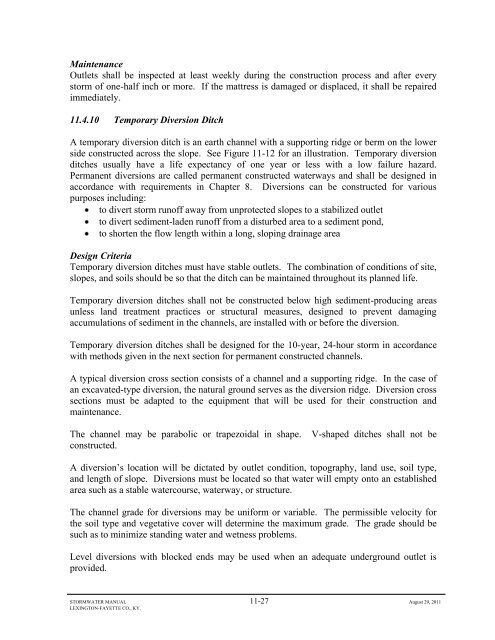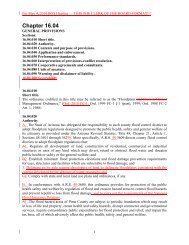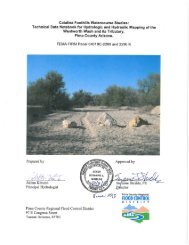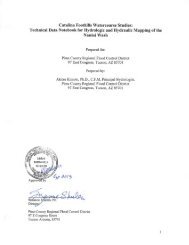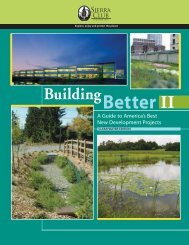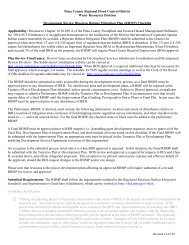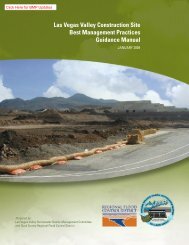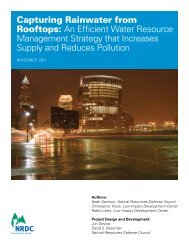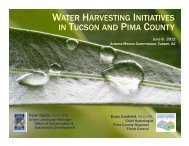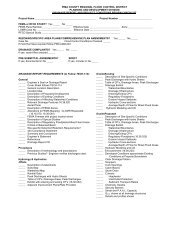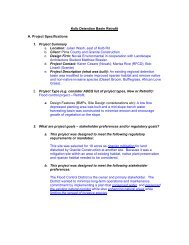Stormwater Manual - Pima County Flood Control District
Stormwater Manual - Pima County Flood Control District
Stormwater Manual - Pima County Flood Control District
Create successful ePaper yourself
Turn your PDF publications into a flip-book with our unique Google optimized e-Paper software.
Maintenance<br />
Outlets shall be inspected at least weekly during the construction process and after every<br />
storm of one-half inch or more. If the mattress is damaged or displaced, it shall be repaired<br />
immediately.<br />
11.4.10 Temporary Diversion Ditch<br />
A temporary diversion ditch is an earth channel with a supporting ridge or berm on the lower<br />
side constructed across the slope. See Figure 11-12 for an illustration. Temporary diversion<br />
ditches usually have a life expectancy of one year or less with a low failure hazard.<br />
Permanent diversions are called permanent constructed waterways and shall be designed in<br />
accordance with requirements in Chapter 8. Diversions can be constructed for various<br />
purposes including:<br />
to divert storm runoff away from unprotected slopes to a stabilized outlet<br />
to divert sediment-laden runoff from a disturbed area to a sediment pond,<br />
to shorten the flow length within a long, sloping drainage area<br />
Design Criteria<br />
Temporary diversion ditches must have stable outlets. The combination of conditions of site,<br />
slopes, and soils should be so that the ditch can be maintained throughout its planned life.<br />
Temporary diversion ditches shall not be constructed below high sediment-producing areas<br />
unless land treatment practices or structural measures, designed to prevent damaging<br />
accumulations of sediment in the channels, are installed with or before the diversion.<br />
Temporary diversion ditches shall be designed for the 10-year, 24-hour storm in accordance<br />
with methods given in the next section for permanent constructed channels.<br />
A typical diversion cross section consists of a channel and a supporting ridge. In the case of<br />
an excavated-type diversion, the natural ground serves as the diversion ridge. Diversion cross<br />
sections must be adapted to the equipment that will be used for their construction and<br />
maintenance.<br />
The channel may be parabolic or trapezoidal in shape.<br />
constructed.<br />
V-shaped ditches shall not be<br />
A diversion’s location will be dictated by outlet condition, topography, land use, soil type,<br />
and length of slope. Diversions must be located so that water will empty onto an established<br />
area such as a stable watercourse, waterway, or structure.<br />
The channel grade for diversions may be uniform or variable. The permissible velocity for<br />
the soil type and vegetative cover will determine the maximum grade. The grade should be<br />
such as to minimize standing water and wetness problems.<br />
Level diversions with blocked ends may be used when an adequate underground outlet is<br />
provided.<br />
STORMWATER MANUAL 11-27 August 29, 2011<br />
LEXINGTON-FAYETTE CO., KY.


